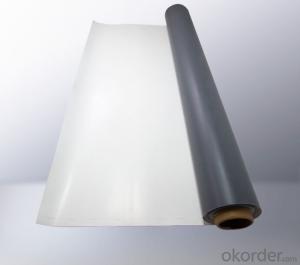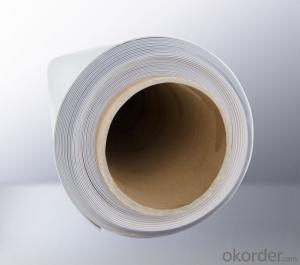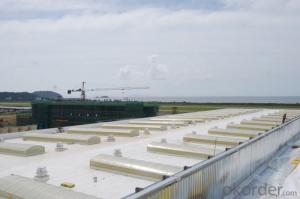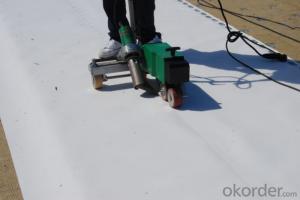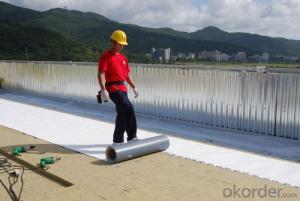(TPO) Polyester Fleece Backing Thermoplastic Polyolefin Waterproof Membrane
- Loading Port:
- Tianjin
- Payment Terms:
- TT or LC
- Min Order Qty:
- 5000 m²
- Supply Capability:
- 100000 m²/month
OKorder Service Pledge
OKorder Financial Service
You Might Also Like
Polyester Fleece Backing Thermoplastic Polyolefin Waterproof Membrane
TPO is a waterproofing sheet, consisting of thermoplastic polyolefin
Compound resin materials as the base stock, reinforced with polyester mesh fabric.
Product Applications:
Widely used in all kinds of building roof(exposed roof,planting roof,driving roof,light steel roof) and basement,tunnel,grain depot,subway,reservoir,etc.
Product Advantages:
1. Weather resistance and durability; Excellent weld ability;
2. No any crisp agents to prevent materials brittleness;
3. Intermediate enhanced polyester mesh fabric to have high tensile strength, fatigue resistance and penetrating resistance suitable for mechanically attached roofing systems;
4. Excellent the same high and low temperature resistance as rubber materials which can keep flexible at -50° C and keep mechanical strength in high temperature;
5. Excellent chemical resistance to acids, bases, and restaurant exhaust emissions; Dimension stability;
6. White-based light-color and smooth surface with high reflection, energy saving and anti-dust functions;
7. Use heat welding for the seam areas to form a reliable seamless waterproof layer.
Product Specifications:
Item | Requirement | Test Method | ||
Thickness, min, mm | Sheet-overall | ≥1.0 | ASTM D6878 | |
Coating over fabric or scrim, weathering side only | ≥0.305 | ASTM D751 | ||
Breaking strength, min, N | ≥976 | ASTM D751 | ||
Elongation at reinforcement break, min, % | ≥15 | ASTM D751 | ||
Tearing strength,min, N | ≥245 | ASTM D751 | ||
Brittleness point, max, °C | ≤-40 | ASTM D2137 | ||
Ozone resistance | no cracks | ASTM D1149 | ||
Properties after heat aging | Breaking strength, % min | ≥90 | ASTM D573 | |
Elongation at reinforcement break, % min | ≥90 | ASTM D573 | ||
Tearing strength, % min | ≥60 | ASTM D573 | ||
Weight change (mass), max % | ≤±1 | ASTM D573 | ||
Linear dimensional change, max, % | ≤±1 | ASTM D1204 | ||
Water absorption, max, mass % | ≤±3.0 | ASTM D471 | ||
Factory seam strength, min, N | ≥290 | ASTM D751 | ||
Weather resistance | Visual inspection | - | ||
FAQ:
Q: Can I get samples from your company?
A: Yes, we could offer free samples if you requirement.
Q: Can I do the third party testing before loading?
A: Yes, we could accept the third party testing.
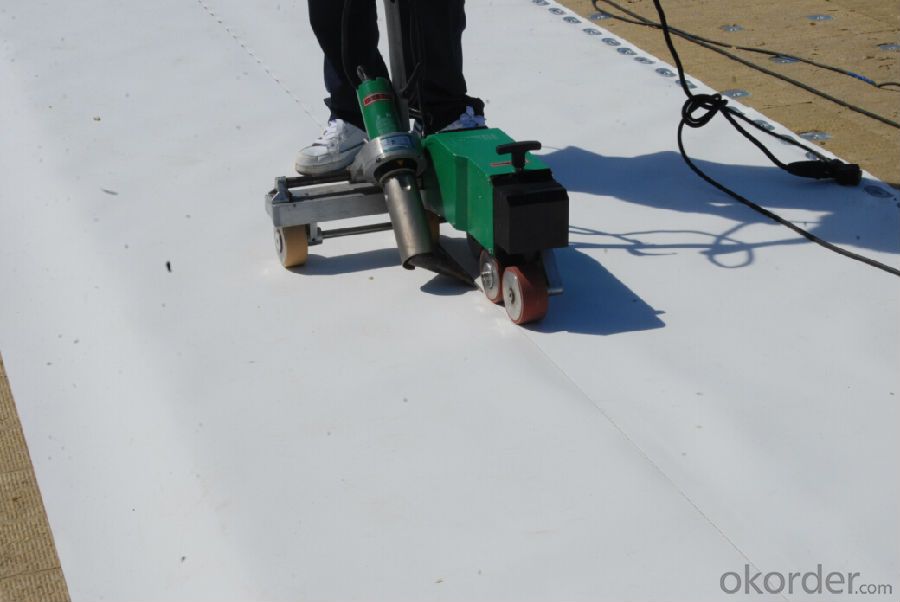
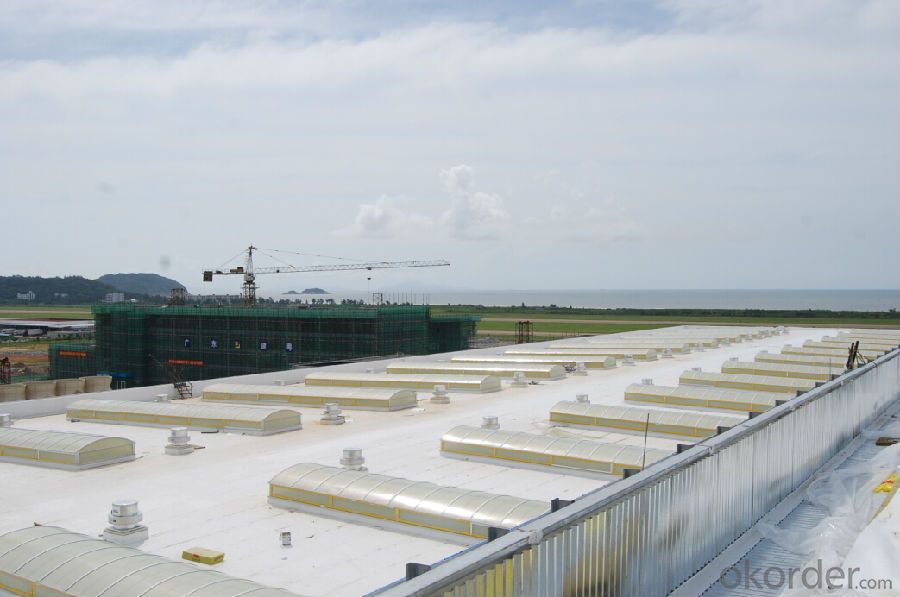
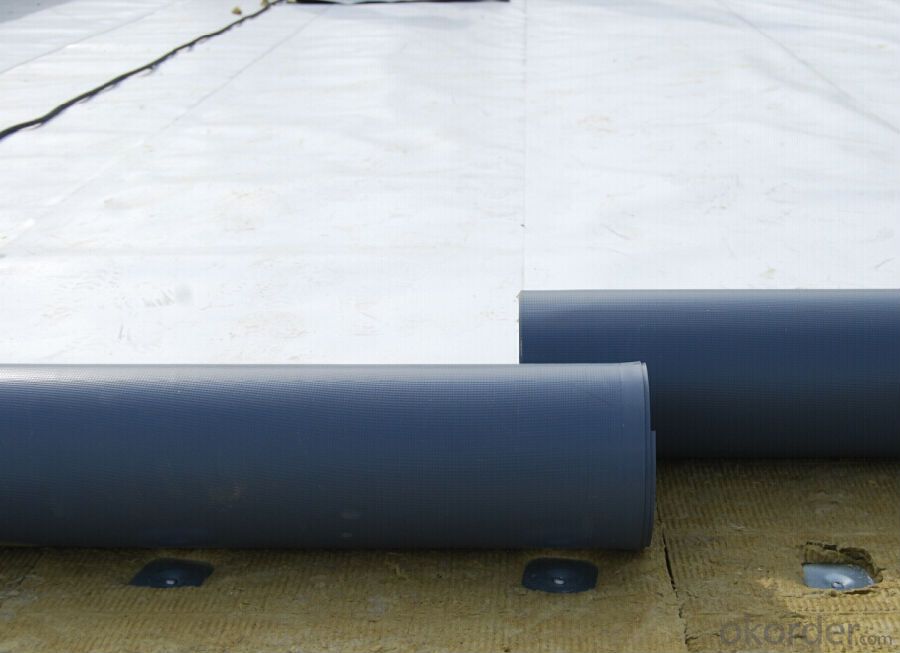

- Q:Can a waterproofing membrane be used in areas with high groundwater levels?
- Yes, a waterproofing membrane can be used in areas with high groundwater levels. In fact, it is highly recommended to use a waterproofing membrane in such areas to protect the structure from water infiltration. A waterproofing membrane is specifically designed to create a barrier against water, preventing it from seeping into the building or structure. This can be particularly important in areas with high groundwater levels, as the pressure from the water can be significant and increase the risk of water damage or flooding. By installing a waterproofing membrane, you can effectively mitigate the risk of water infiltration and ensure the longevity and durability of the structure.
- Q:Can waterproofing membranes be used on concrete surfaces?
- Yes, waterproofing membranes can be used on concrete surfaces. These membranes are specifically designed to provide a protective barrier against water penetration and can be applied to concrete to prevent water damage and leakage.
- Q:Can a waterproofing membrane be used in areas with high humidity?
- Yes, a waterproofing membrane can be used in areas with high humidity. In fact, high humidity can often contribute to the need for waterproofing as it can lead to moisture buildup and potential water damage. Waterproofing membranes are designed to create a barrier that prevents water from seeping through surfaces, such as walls or floors. They can effectively protect against moisture and water infiltration, which is particularly important in high humidity areas where the risk of water damage is greater. By applying a waterproofing membrane, you can significantly reduce the likelihood of mold, mildew, and other moisture-related issues in these environments.
- Q:Can a waterproofing membrane be used on plastic block surfaces?
- Indeed, it is possible to utilize a waterproofing membrane on surfaces composed of plastic blocks. These membranes are specifically engineered to serve as a safeguard against moisture, effectively hindering water infiltration. Similar to any other type of surface, plastic blocks are prone to water-related harm if not adequately shielded. By applying a waterproofing membrane, one can successfully seal and safeguard the plastic blocks, thus thwarting water permeation and potential destruction. To achieve optimal outcomes, it is crucial to select a waterproofing membrane that harmonizes with plastic materials and adhere to the manufacturer's application guidelines.
- Q:Are waterproofing membranes resistant to hydraulic oils?
- Waterproofing membranes are typically not resistant to hydraulic oils. Hydraulic oils are designed to be highly lubricating and can often penetrate and degrade the integrity of waterproofing membranes. Therefore, it is important to ensure that if hydraulic oils are present in an area where waterproofing is required, additional protective measures, such as using chemical-resistant membranes or applying suitable coatings, are taken to prevent any potential damage to the waterproofing system. It is always recommended to consult with a professional waterproofing contractor or manufacturer for specific recommendations regarding the compatibility of waterproofing membranes with hydraulic oils in a particular application.
- Q:Can a waterproofing membrane be used on roofs or only on vertical surfaces?
- Both roofs and vertical surfaces can benefit from the use of a waterproofing membrane. It is a common practice to utilize this membrane to safeguard roofs against water-related harm. Specifically designed as a barrier against water infiltration, roofing membranes guarantee a dry and leak-free structure. These membranes are applied to the roof's surface, forming a protective layer that prevents water from seeping through. In a similar manner, waterproofing membranes can also be employed on vertical surfaces, such as walls, to prevent water ingress and safeguard the underlying structure. The primary objective of a waterproofing membrane is to establish a watertight seal, regardless of whether it is used on a horizontal or vertical surface. Therefore, whether it is a roof or a vertical wall, a waterproofing membrane is an effective solution for shielding against water damage.
- Q:Can waterproofing membranes be used on below-grade parking structures?
- Yes, waterproofing membranes can be used on below-grade parking structures. These membranes are designed to prevent water infiltration and protect the structure from potential water damage. They are commonly used in below-grade applications to ensure the longevity and structural integrity of the parking facility.
- Q:Can a waterproofing membrane be used on terraces or patios?
- Yes, a waterproofing membrane can be used on terraces or patios. In fact, it is highly recommended to use a waterproofing membrane in these areas to prevent water damage and leakage. Terraces and patios are exposed to various weather conditions, including rain and snow, which can lead to moisture seeping into the underlying structure. A waterproofing membrane acts as a barrier, preventing water from penetrating the surface and protecting the integrity of the terrace or patio. It helps to extend the lifespan of the structure and prevents costly repairs in the long run. Additionally, using a waterproofing membrane also helps to create a more comfortable and usable space, as it eliminates the risk of water accumulation and potential slip hazards. Overall, investing in a high-quality waterproofing membrane is a wise decision for anyone looking to protect their terrace or patio from water damage.
- Q:Can a waterproofing membrane be used for sealing pipe penetrations?
- Yes, a waterproofing membrane can be used for sealing pipe penetrations. Waterproofing membranes are designed to create a barrier against water and moisture, making them suitable for sealing pipe penetrations to prevent water leakage or intrusion.
- Q:Can a waterproofing membrane be used in elevator pits or sump pits?
- Yes, a waterproofing membrane can be used in elevator pits or sump pits. Elevator pits and sump pits are prone to water infiltration, and a waterproofing membrane can effectively prevent water from seeping into these areas. The membrane acts as a barrier, preventing any water from entering the pit and causing damage to the elevator or pumping system. This helps to maintain the integrity of the elevator or pump and prolong its lifespan. Additionally, a waterproofing membrane can also protect the surrounding structures and prevent any water damage. It is important to select a suitable waterproofing membrane that is designed for below-ground applications and has the necessary properties to withstand the specific conditions in an elevator or sump pit.
1. Manufacturer Overview |
|
|---|---|
| Location | |
| Year Established | |
| Annual Output Value | |
| Main Markets | |
| Company Certifications | |
2. Manufacturer Certificates |
|
|---|---|
| a) Certification Name | |
| Range | |
| Reference | |
| Validity Period | |
3. Manufacturer Capability |
|
|---|---|
| a)Trade Capacity | |
| Nearest Port | |
| Export Percentage | |
| No.of Employees in Trade Department | |
| Language Spoken: | |
| b)Factory Information | |
| Factory Size: | |
| No. of Production Lines | |
| Contract Manufacturing | |
| Product Price Range | |
Send your message to us
(TPO) Polyester Fleece Backing Thermoplastic Polyolefin Waterproof Membrane
- Loading Port:
- Tianjin
- Payment Terms:
- TT or LC
- Min Order Qty:
- 5000 m²
- Supply Capability:
- 100000 m²/month
OKorder Service Pledge
OKorder Financial Service
Similar products
New products
Hot products
Hot Searches
Related keywords
